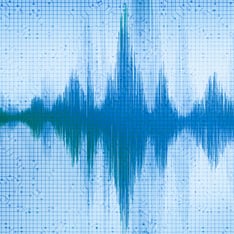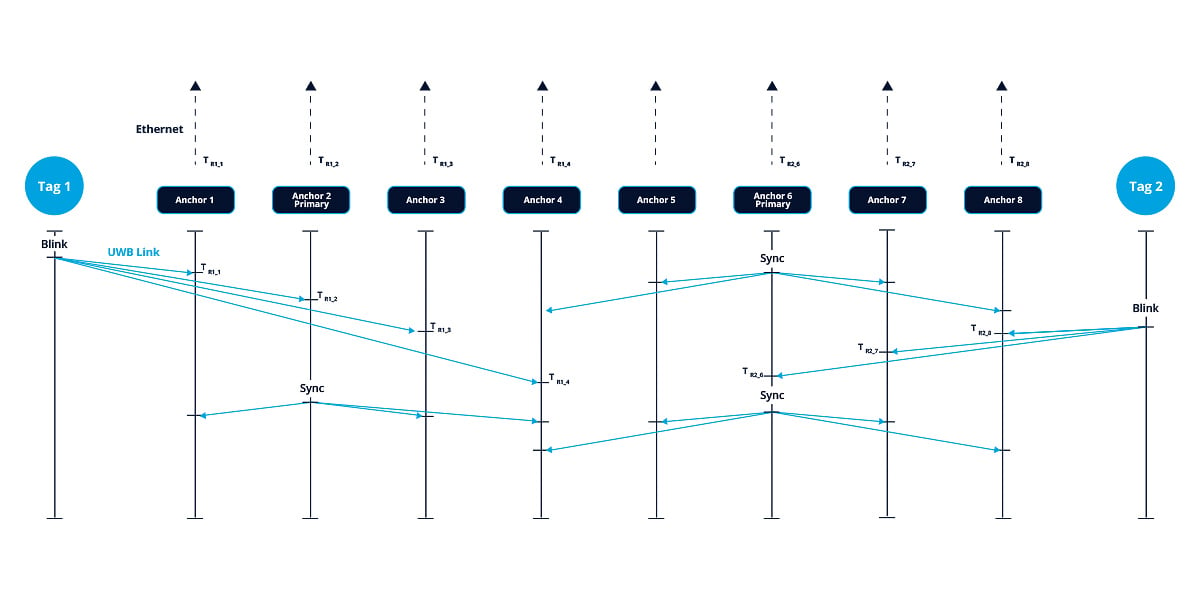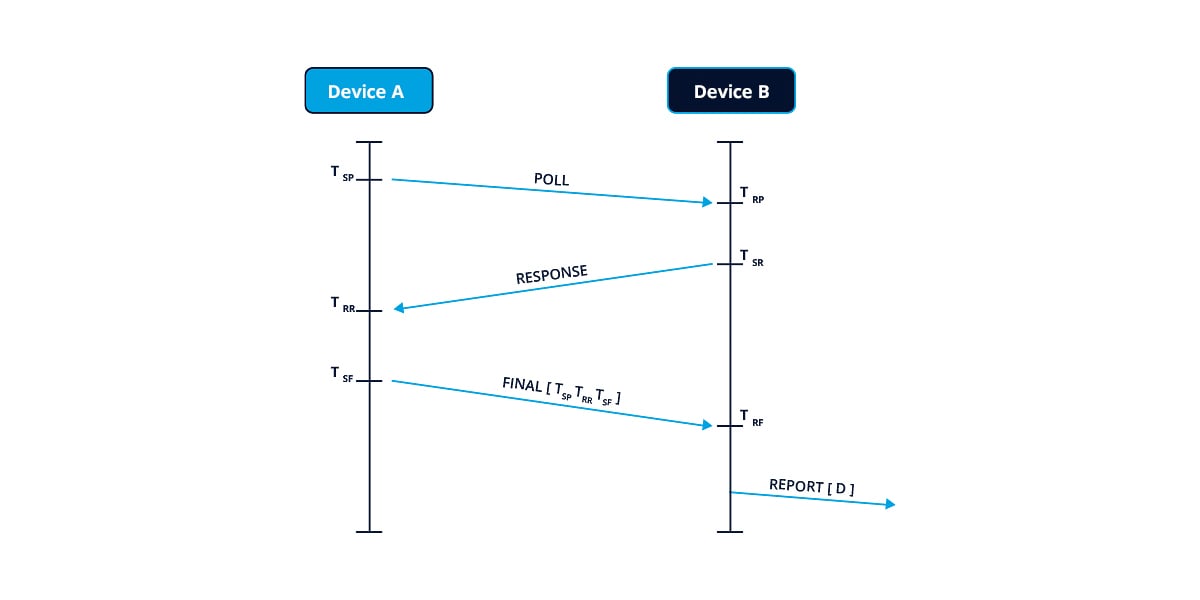Learn more about UWB and how this precise, quick, and reliable radio-frequency (RF) technology can be used to enable advanced real-time location systems and asset tracking deployments.
Ultra-wideband, or UWB, is a short-range RF technology for wireless communication that can be leveraged to detect the location of people, devices, and assets with unrivaled precision. Like other communication protocols including Bluetooth and Wi-Fi, UWB can be used to transmit data between devices through radio waves. It does so with short nanosecond pulses over an “ultra-wide” range of frequencies.
UWB technology uses billions of pulses of radio that are sent every couple of nanoseconds as a pattern across a wide frequency spectrum (at least 500 MHz or 20% of the center frequency). These signals are dispatched from a transmitter to a receiver, or amongst transceivers. The receiving device analyzes the incoming pattern and translates it into data. While this allows devices to quickly send data over short ranges, these UWB signals can also be used to accurately sense the location of devices. This makes it possible for UWB-enabled devices (like smartphones or sensors and anchors) to pinpoint a transmitting device, such as another smartphone or asset tracking tag, find its precise location, and in certain applications enable location-aware communication and services.
While recent adoption in next-gen smartphones and other technologies may make it seem like a new, cutting-edge technology, UWB has seen applied use for decades. In many years, its use was limited or restricted and most typically seen in military radar and communication applications, under the name “pulse radio”. In 2002, the FCC authorized its unlicensed use. Since that decision, UWB technology has seen great innovation and development that are beginning to unlock transformative location-based capabilities.

UWB has many unique advantages that have led to it swiftly setting a new standard for RF technology. It can transmit very high data rates over short ranges, and pinpoint exact location in real-time. UWB operates with a high bandwidth over a very wide frequency spectrum between 3.1 to 10.6 GHz. It also consumes very little power, allowing for affordable and efficient hardware options, such as tracking tags with coin cell batteries that can operate for multiple years without being recharged or replaced.
The reason UWB can so precisely detect location is due to its distance-based measurement via time-of-flight (ToF), that calculates location based on how long it takes for pulses of radio to travel from one device to another. While this only works over shorter ranges, the location of UWB signals can be determined with an accuracy of less than 50 centimeters (with optimal conditions and deployment), and extremely low latency. Other standards like BLE and Wi-Fi , usually cannot be used to do this, and instead typically determine location via rather unreliable received signal strength indicators (RSSI) only showing rough categories of “weak” or “strong” received signals, which grants location accuracy into the meter level.
The low transmission power and wide spectrum of frequencies UWB signals are sent with, allow for little to no interference with surrounding narrowband technologies. UWB also appears to be “invisible at noise floor”, making it a good choice for coexistence with narrowband RF technologies. These unique properties are why UWB is quickly emerging as a premier indoor positioning technology for location-based and short-range communication applications.
UWB makes it possible to determine location via ToF. This can precisely measure distance between transceivers by calculating the time it takes for signals to travel amongst the devices. In certain scenarios the X,Y, and Z coordinates of a device’s location can be detected, adding an additional dimension to the localization UWB can provide. Based on the use case or application, the exact technique of the ToF calculation can differ.
For UWB positioning, there are two primary techniques that can be used: Time Difference of Arrival (TDoA) and Two-Way Ranging (TWR).
 Time Difference of Arrival (TDoA)
Time Difference of Arrival (TDoA)TDoA utilizes UWB anchors or sensors that are deployed in a fixed position throughout an indoor space. These sensors then detect and locate a transmitting UWB device, such as a tracking tag. To work properly the fixed anchors need to be accurately synchronized to run on the same clock. The UWB tag, or other device will transmit signals in regular intervals. These signals will be received by any anchors in the communication range and time-stamped by the anchors. All the time-stamped data is then sent to the central IPS or RTLS.
The location engine will analyze each anchor’s data and the differences in arrival times to each anchor and use multilateration to calculate the tag’s coordinates. Those coordinates can be used to visualize the location of the device on an indoor map of your space or leveraged for other uses depending on the specific application.
 Two Way Ranging (TWR)
Two Way Ranging (TWR)While in TDoA multiple fixed anchors work together to determine the location of a mobile object, TWR primarily uses two-way communication between two devices, such as smartphones, to sense the distance between them. With TWR, when a device is in close proximity to another, the two devices will start ranging with each other to determine their distance, even as they communicate. The time it takes a signal to travel between them is then multiplied by the speed of light and used to determine their relative positions, frequently to enable location-aware communication.
The determined location from one device to another is then harnessed depending on the specific application. TWR can also be used by fixed anchors and UWB devices, however the TWR process can only use one ranging partner to locate the device at a time.
UWB’s ability to detect via ToF, quick nanosecond pulses, and limited interference with other RF transmissions, allow for precise indoor positioning at an accuracy below 50 centimeters (optimal conditions and deployment), with real-time results that also quickly track device movement and motion.
Compared to other technologies for indoor positioning, UWB yields far superior location accuracy. Other standards typically utilize Received Signal Strength Indicator (RSSI) to determine location and can usually only do so at an accuracy in the meter range, such as BLE (< 5 meters) and Wi-Fi (< 10 meters). Some UWB technology can also use Angle of Arrival (AoA) to even more precisely measure location with direction finding, which requires devices with multiple antennas that can measure the angle of an incoming signal.
UWB can detect the location of a device over a range under 200 meters. However, it operates most effectively over short ranges, generally between 1-50 meters, and works best with line of sight between devices or anchors. Across short-ranges UWB can deliver highly accurate, quick and secure communications, with minimal interference.
Ultra-wideband, like each RF standard, offers unique characteristics and advantages that may make it a suitable option depending on individual needs, budget, facility, and specific location-based use case. The most critical differences between UWB and other technologies are its wide frequency spectrum and the level of accuracy it can provide. UWB’s precision makes it an effective option, particularly in advanced indoor positioning use cases such as asset tracking scenarios, where absolute location and real-time movement is crucial.
UWB and BLE have many common attributes - low power, low cost, strength as an asset tracking technology, etc. However, UWB can deliver far superior accuracy than Bluetooth. This is in large part due to UWB’s precise distance-based method to determine location via ToF. BLE positioning technology typically locates devices via RSSI, which estimates distance and yields a considerably lower level of accuracy based on whether a device is transmitting a strong or weak signal relative to a beacon or sensors. BLE also has a much shorter range and data rate than UWB, and is more prone to signal interference. Bluetooth does have an enormous ecosystem and has been a leading indoor positioning technology for quite some time. It is used by so many of today’s wireless devices and a very popular option for locationing, offering an extensive set of flexible hardware options that can easily be implemented, such as BLE beacons.
Wi-Fi’s vast presence in our devices and indoor spaces, have made it a key RF technology for indoor location. In advanced location-based scenarios, Wi-Fi can be limited due to it’s low accuracy and flexibility. UWB excels in these more advanced applications where a high degree of accuracy is required. Wi-Fi’s accuracy is far less than UWB, because it typically measures location not by distance, but rather signal strength, just as Bluetooth. It is also more likely to experience signal interference, which UWB has strong immunity to. UWB also requires less power, allowing for more useful and affordable tools, such as asset tracking tags that can be powered by long lasting coin cell batteries. However, the wide array of Wi-Fi enabled devices and ability to leverage existing infrastructure, such as Access Points, make it a very important indoor positioning technology, especially when a high degree of accuracy is not required.
* with optimal conditions and deployment
UWB technology provides accuracy down to the centimeter-level, making it the premier choice for advanced location-based applications, unlocking a multitude of capabilities never before possible.
UWB delivers lightning-fast location results. Quick nanoseconds communications allow for true real-time indoor positioning and locationing with incredibly low latency and refresh rates beyond 100 times per second, allowing users to instantly sense location, movement, and motion of personnel, assets or vehicles.
With limited-to-no interference or overlap with other radio transmissions, UWB allows for very reliable communication. Using the precise location of the receiving device, UWB can also be used for incredibly secure communications between devices over a small distance.
UWB’s accuracy makes it an effective option particularly in advanced indoor positioning use cases where a high degree of precision is required. It shines as the RTLS enabler of the future and is exceptionally adept in various asset tracking applications. Here are some use cases and applications where UWB is currently being used, as well as might be used in the future:
What’s Next for UWB? |
UWB is poised to see continued adoption into consumer and enterprise technology. UWB-enabled chips will likely be embedded into more devices like smartphones, wearables, cars, and more. Indoor spaces will likely begin to implement fixed UWB infrastructure for various location-based applications. It is predicted that between 2022-2024, upon completion of IEEE 802.15 4z standard development, which is used to combine sensors and actuators into a single wireless network, UWB technology will be more actively used in both mass market and enterprise solutions. This adoption of UWB technology will unlock powerful new capabilities and tools that will add a new dimension to indoor positioning and short range communication. |